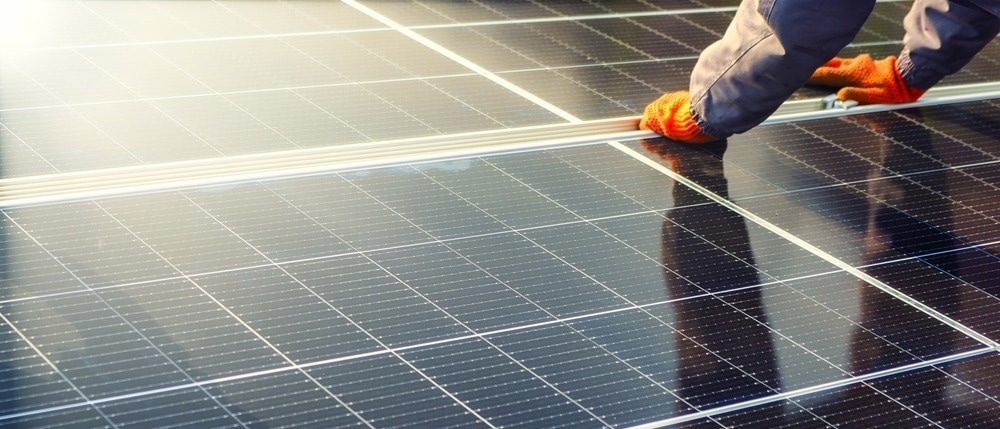 By Taha KhanReviewed by Lexie CornerMar 13 2024
By Taha KhanReviewed by Lexie CornerMar 13 2024This article explores how hemispherical-shell-shaped organic photovoltaic cells are transforming photovoltaics for more sustainable energy solutions.

Image Credit: AlyoshinE/Shutterstock.com
Importance of Sustainable Energy Solutions
Due to the environmental concerns and limits associated with conventional energy sources, such as finite fossil fuels, the world is shifting towards renewable and sustainable energy options.
Renewable energy sources like solar, wind, and water help tackle problems caused by greenhouse gas emissions, climate change, and air pollution. They also enhance energy security, diminishing the dependence on geopolitically sensitive fuel sources.
As a result, researchers are focusing on developing novel technologies that support the renewable energy sector and enhance the efficiency of current technologies.
Significance of Solar Energy
Solar energy is the most abundantly available green energy; however, its contribution to the global energy sector remains below its potential. For instance, a 2019 report revealed that solar energy accounted for less than two percent of the 200GW of global green energy capacity addition, despite it being one of the most rapidly growing energy sectors.
This discrepancy can be attributed to several factors, with the low efficiency of photovoltaic cells being a prominent obstacle. This limitation reduces the net output of solar systems.
Challenges of Conventional Organic Photovoltaic Cells
Organic photovoltaic cells convert sunlight into electricity through the photovoltaic effect. Light absorption within the cell's active layer generates electron-hole pairs, which are then separated and collected by electrodes to produce an electric current.
However, conventional flat organic photovoltaic cell designs have several limitations that reduce their overall efficiency. For instance, planar active layers can only capture light that strikes them at specific angles, which significantly reduces the amount of usable sunlight, especially for diffuse light or light incident at oblique angles.
Similarly, light entering the active layer can travel a short distance before being re-emitted or lost, limiting the probability of light absorption and electron-hole pair generation. Together, these challenges result in lower power conversion efficiencies in conventional organic photovoltaic cells compared to their silicon-based counterparts.
Novel Hemispherical-Shell-Shaped Organic Photovoltaic Cells
Several efforts have been made to address the efficiency challenges and other issues facing photovoltaic cells. Among these, a groundbreaking approach reported in a 2024 study stands out: the introduction of novel hemispherical-shell-shaped organic photovoltaic cells to improve absorption and enhance angular coverage.
Three-dimensional finite element analysis (3D-FEA) was employed to evaluate the absorption spectra within the proposed structure. Here, the absorption enhancements of the hemispherical shell structure were compared with both flat-structured and semicylindrical shell-structured devices. The study focused on the radius of the hemisphere (R), and simulations were performed with hexagonal periodicity.
The hemispherical-shell-shaped design has shown significant promise, boasting absorption improvements of 66 % (TE-polarized) and 36 % (TM-polarized) compared to flat-structured devices and 13 % (TE) and 21 % (TM) compared to semicylindrical shell structures.
The angular coverage of the proposed structure was also significantly improved, reaching 81 degrees (TE) and 82 degrees (TM). This makes it particularly suitable for wearable electronics where incident light angles vary randomly.
Advancements in Photovoltaics: The Impact on Sustainable Energy
The study addresses the crucial need for advancements at the photovoltaic device level, specifically from an optical design perspective.
The proposed unique hemispherical shell structure aims to overcome challenges organic photovoltaic solar cells face, such as the conflict between efficient photon absorption and charge carrier collection.
This design philosophy could transform photovoltaics, making strides toward more sustainable energy solutions. It offers an effective solution to enhance light coupling, retention, and angular coverage in solar cells.
Application of Hemispherical-Shell-Shaped Organic Photovoltaic Cells
The study envisions practical applications of the proposed hemispherical-shell-shaped active layers in various organic solar cell domains. Potential areas include biomedical devices, semitransparent solar applications (such as power generation windows and greenhouses), and indoor applications like the Internet of Things (IoT).
These findings lay the foundation for optimizing the proposed structure, emphasizing a radius of 1μm as sufficient for reaping benefits. As a result, this study has opened opportunities for future exploration, development, and implementation of innovative organic photovoltaic cell designs with improved absorption and omnidirectional characteristics.
Conclusion
The growing need for sustainable energy solutions highlights the need to enhance solar energy utilization. Hemispherical-shell-shaped organic photovoltaic cells have emerged as a promising solution, offering significant absorption improvements compared to traditional flat and semicylindrical structures.
This novel but simple approach presents an opportunity for further exploration and development of advanced organic photovoltaic cell designs to contribute to a more sustainable energy future.
More from AZoOptics: Recent Advances in Sustainable Photonics Materials
References and Further Reading
Ghosh, BK., Jha, PK., Ghosh, SK., Biswas, TK. (2023). Organic solar cells pros and cons: Outlooks toward semitransparent cell efficiency and stability. AIP Advances. doi.org/10.1063/5.0124743
Hah, D. (2024). Hemispherical-shell-shaped organic photovoltaic cells for absorption enhancement and improved angular coverage. Journal of Photonics for Energy. doi.org/10.1117/1.JPE.14.018501
Herrando, M., et al. (2023). A review of solar hybrid photovoltaic-thermal (PV-T) collectors and systems. Progress in Energy and Combustion Science. doi.org/10.1016/j.pecs.2023.101072
Lowrie, W., Westbrook, RJ., Guo, J., Gonev, HI., Marin-Beloqui, J., Clarke, TM. (2023). Organic photovoltaics: The current challenges. The Journal of Chemical Physics. doi.org/10.1063/5.0139457
W. Weiss, M. Spokr-dur. (2023) Solar heat worldwide. [Online] SHC. Available at: https://w.iea-shc.org/Data/Sites/1/publications/Solar-Heat-Worldwide-20231.pdf
Disclaimer: The views expressed here are those of the author expressed in their private capacity and do not necessarily represent the views of AZoM.com Limited T/A AZoNetwork the owner and operator of this website. This disclaimer forms part of the Terms and conditions of use of this website.